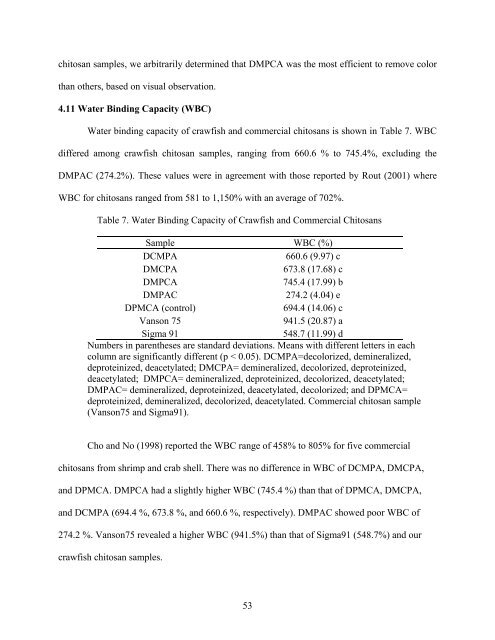physicochemical and functional properties of crawfish chitosan as ...
physicochemical and functional properties of crawfish chitosan as ...
physicochemical and functional properties of crawfish chitosan as ...
You also want an ePaper? Increase the reach of your titles
YUMPU automatically turns print PDFs into web optimized ePapers that Google loves.
<strong>chitosan</strong> samples, we arbitrarily determined that DMPCA w<strong>as</strong> the most efficient to remove color<br />
than others, b<strong>as</strong>ed on visual observation.<br />
4.11 Water Binding Capacity (WBC)<br />
Water binding capacity <strong>of</strong> <strong>crawfish</strong> <strong>and</strong> commercial <strong>chitosan</strong>s is shown in Table 7. WBC<br />
differed among <strong>crawfish</strong> <strong>chitosan</strong> samples, ranging from 660.6 % to 745.4%, excluding the<br />
DMPAC (274.2%). These values were in agreement with those reported by Rout (2001) where<br />
WBC for <strong>chitosan</strong>s ranged from 581 to 1,150% with an average <strong>of</strong> 702%.<br />
Table 7. Water Binding Capacity <strong>of</strong> Crawfish <strong>and</strong> Commercial Chitosans<br />
Sample WBC (%)<br />
DCMPA 660.6 (9.97) c<br />
DMCPA 673.8 (17.68) c<br />
DMPCA 745.4 (17.99) b<br />
DMPAC 274.2 (4.04) e<br />
DPMCA (control) 694.4 (14.06) c<br />
Vanson 75 941.5 (20.87) a<br />
Sigma 91 548.7 (11.99) d<br />
Numbers in parentheses are st<strong>and</strong>ard deviations. Means with different letters in each<br />
column are significantly different (p < 0.05). DCMPA=decolorized, demineralized,<br />
deproteinized, deacetylated; DMCPA= demineralized, decolorized, deproteinized,<br />
deacetylated; DMPCA= demineralized, deproteinized, decolorized, deacetylated;<br />
DMPAC= demineralized, deproteinized, deacetylated, decolorized; <strong>and</strong> DPMCA=<br />
deproteinized, demineralized, decolorized, deacetylated. Commercial <strong>chitosan</strong> sample<br />
(Vanson75 <strong>and</strong> Sigma91).<br />
Cho <strong>and</strong> No (1998) reported the WBC range <strong>of</strong> 458% to 805% for five commercial<br />
<strong>chitosan</strong>s from shrimp <strong>and</strong> crab shell. There w<strong>as</strong> no difference in WBC <strong>of</strong> DCMPA, DMCPA,<br />
<strong>and</strong> DPMCA. DMPCA had a slightly higher WBC (745.4 %) than that <strong>of</strong> DPMCA, DMCPA,<br />
<strong>and</strong> DCMPA (694.4 %, 673.8 %, <strong>and</strong> 660.6 %, respectively). DMPAC showed poor WBC <strong>of</strong><br />
274.2 %. Vanson75 revealed a higher WBC (941.5%) than that <strong>of</strong> Sigma91 (548.7%) <strong>and</strong> our<br />
<strong>crawfish</strong> <strong>chitosan</strong> samples.<br />
53

















